To build your own Itinerary, click  to add an item to your Itinerary basket.
to add an item to your Itinerary basket.
Already saved an Itinerary?

You are here: Creative Maidstone > Useful Information > Famous Artists

Tony Hart was born in Hastings Road, Maidstone in 1925 and displayed a talent for art from an early age.
On leaving school in 1943, he joined the British Indian Army and gained an officer’s commission with the 1st Gurkha Rifles with whom he served from 1943 – 1947. After being demobilised, he decided to become a professional artist and studied at Maidstone College of Art. He graduated in 1950 and soon became a freelance artist.
Tony’s break into television came in 1952 after meeting a BBC TV producer at a party and becoming resident artist on the Saturday Special programme. Subsequent TV shows included Playbox (1954–59), Tich and Quackers (1963-67), Vision On (1964–76), Take Hart (1977–83), Hartbeat (1984–93), Artbox Bunch (1995–96) and Smart Hart (1999–2000). As well as demonstrating small-scale projects, he also created large-scale artworks on the TV studio floor, and even used beaches, car parks and hillsides as 'canvases'. He also designed the original sailing ship logo for the BBC children’s programme Blue Peter.
In 1977, he was joined by his mischievous sidekick Morph, the animated Plasticine stop-motion character created by David Sproxton and Peter Lord of Aardman Animations.
A regular feature of Tony’s programmes was The Gallery, which displayed artworks sent in by young viewers, still remembered fondly by many.
Tony received two BAFTA awards: Best Children's Educational Programme in 1984 for Take Hart; and a Lifetime Achievement Award in 1998. He retired from regular TV work in 2001.

Ralph Steadman was born in 1936. Having completed his National Service in 1954, during which time he completed the Percy V. Bradshaw Press Art School correspondence course, he moved to London and started work as a cartoonist. His first cartoon was published in the Manchester Evening Chronicle in 1956.
In 1959, frustrated by the limits of his skills, he enrolled at East Ham Technical College to learn the ‘discipline of drawing’. It was here he met his mentor, Leslie Richardson, who taught life drawing.
1960 saw his first appearance in Punch magazine, where he eventually progressed to cover design. In 1961, encouraged by Richardson, he enrolled at the London College of Printing. By this point he was beginning to find the demands of newspaper cartooning too restrictive: ‘Cartooning wasn’t just making a little picture and putting a caption underneath. It’s also something else – a vehicle for expression of some sort, protest, or it’s actually a way of saying something which you cannot necessarily say in words.’
In 1961 he wrote to the editor of newly founded Private Eye and began to explore a new, more provocative style, drawing on influences like George Grosz and John Heartfield. During the 1960s he illustrated several children’s books, including Fly Away Peter (1964), The Big Squirrel and the Little Rhinoceros (1965), The False Flamingos (1967), and The Jelly Book (1967), which he also wrote. His work was regularly appearing in New Society, Radio Times, Town, New Musical Express and the Daily Telegraph.
In 1967 he began work on his illustrated Alice in Wonderland, which won the Frances Williams Award in 1972. In 1970, having published his first collected book of cartoons, Still Life with Raspberry, he set off to America to cover the Kentucky Derby for Scanlan’s Monthly, where everything would change on his meeting Hunter S. Thompson. Together they would develop ‘Gonzo’ journalism, where you do not simply cover the story but become the story. So began a lifelong collaboration, including the iconic Fear and Loathing in Las Vegas, which was originally serialized in Rolling Stone Magazine. Another lifelong association was begun, and Steadman is still listed as Gardening Correspondent for the legendary publication.
Between projects with Hunter, including Fear and Loathing on the Campaign Trial ‘72, The Curse of Lono (1983) and Polo is My Life (1994), and numerous pieces for Rolling Stone, Steadman continued to produce his own books, including Sigmund Freud (1979), I Leonardo (1983), The Big I Am (1998), as well as children’s books such as That’s My Dad (1986), No Room to Swing a Cat (1989) and Teddy! Where Are You? (1994).
In 1987 Steadman was approached by Oddbins to travel the vineyards of the world and produce artwork for their catalogues. Between 1987 and 2000 he did just that, producing hundreds of
artworks, many of which would eventually appear in his two award winning books on wine, The Grapes of Ralph and Untrodden Grapes, and his book about whisky, Still Life with Bottle.
He has always diversified in his career, producing theatre sets for a ballet of The Crucible (2000) performed at the Royal Opera House; a production of Gulliver’s Travels (1995) for Clwyd Theatr Cymr; and an oratorio and images for an eco-opera, The Plague and the Moonflower, with music composed by Richard Harvey.
He has illustrated three books about extinct and endangered birds and animals with co-Gonzovationist Ceri Levy, Extinct Boids (2012), Nextinction (2015) and Critical Critters (2017) as well as producing a set of portraits for the cult TV show Breaking Bad, which feature on its special edition DVD and Blu-ray. In 2012 a film of his life and influences, 15 years in the making, called For No Good Reason premiered at the Toronto Film Festival to critical acclaim.
In recent years companies including Vans, Supreme and Nike have collaborated with Ralph to produce product ranges within their brands. He produced artwork for the documentary on Shane McGowan: A Crock of Gold, produced by Johnny Depp. He has created portraits of Jack Harlow and Bob Dylan and also penned his own version of the alphabet - the Ralphabet.
Ralph Steadman is drawing and creating today, at the age of 88, pen in hand, fingers stained with ink.
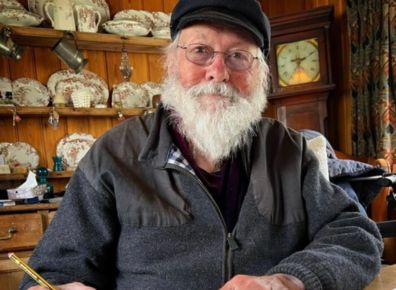
Born in 1941, artist and author Graham Clarke is internationally renowned for his wonderfully detailed, often humorous arch-topped limited-edition etchings produced entirely by hand using methods over 200 years old.
His works celebrate his love of the Kent countryside, boats and the sea, Cornwall, travel to Europe and beyond, comic misinterpretations of history, Shakespeare and much more besides.
Graham sold his first work to a neighbour at the age of eight launching his career as an artist. His interest in printmaking developed during his time at Beckenham School of Art and The Royal College of Art. He set about depicting the beauty of rural life and went on to learn the process of copperplate etching, enabling him to
include more detail in his images.
His work won him recognition from the foremost art patron of the day, Sir Kenneth Clark. In 1973 he came to public attention when his etching ‘Dance by the Light of the Moon’ featured in The Royal Academy’s Summer Exhibition where the edition sold out.
Graham's work is now held by many collections and museums worldwide including The Victoria and Albert Museum, British Museum, Tate Gallery, New York Public Library and The Hiroshima Peace Museum; but what pleases him most is that it is enjoyed in homes locally and all over the world. The most frequent comment being, “We’ve had this on our wall for years but we still keep finding new details to enjoy.”
Graham’s studio is in nearby Boughton Monchelsea where he has lived and worked with his wife Wendy and family since 1968.
www.grahamclarke.co.uk hello@grahamclarke.co.uk @graham_clarke_artist

Mike has been a notable Kent artist since coming to Maidstone in 1968. He taught for a brief period at Maidstone College of Art, when it was based in St Faith’s Street. He is a Fellow of the Royal Watercolour Society; Vice-President, Royal Society of Painter-Printmakers; and a Fellow of the Royal Society of Arts.
He has notably painted for the Late Queen Elizabeth II, commemorating her 90th birthday celebrations.
He has worked extensively with the family of JMW Turner, making videos for Tate Britain on his working techniques. He was honoured to mix and use pigments from Turner’s studio for demonstrations in books and on film. He worked with Japan’s National Television Company recreating Turner’s ‘Ship caught in a snow storm at sea’.
Mike is admired internationally for his watercolours, oils and etchings. He is perhaps immediately known in the UK as the featured art expert in more than 60 programmes of ‘Watercolour Challenge’, the popular Channel 4 daily summer series from 1998-2001.
Although still having a home and studio in Bearsted, he is presently based in Savannah, USA. For the past six years he has devoted much of his time to writing novels with the first being published in Summer 2025 – ‘The Cradle Plank Affair’ (Book one of the ‘Starchild Trilogy’). To date he has written ten novels.
Mike is an honorary villager of Hunan Artists Town in China and is due to have a one-man exhibition there in the near future. His work is in public and private collections worldwide.
Please visit www.mikechaplin.com or www.michaelchaplin.com for more information.
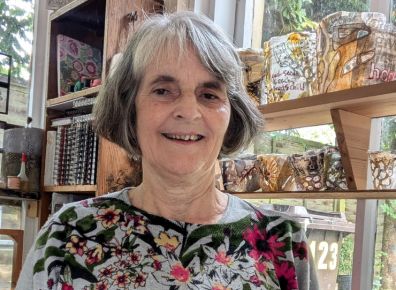
Cas is a Maidstone based artist and author of Romani descent. She studied Fine Art at Maidstone College of Art (University of Creative Arts) and later received Churchill and Japan Foundation Fellowships to continue studies in Japan .
Her work is exhibited internationally and represented in public and private collections. She also tutors at the prestigious West Dean College.
She is the author of several textile publications for Batsford Books. Find out more at: www.casholmes.co.uk
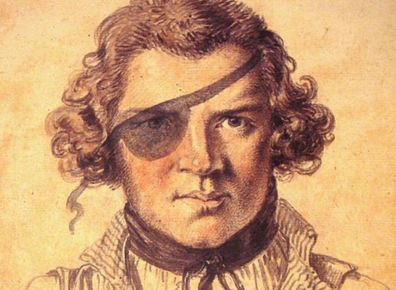
William Alexander was born in Maidstone in 1767 and attended Maidstone Grammar School.
He moved to London at the age of 15 and was admitted to the Royal Academy Schools in 1784, where he soon excelled, gaining the admiration of Sir Joshua Reynolds.
In 1792, he travelled on an embassy to China, when that country was still largely unvisited by Westerners, and came back with scores of drawings and paintings illustrating what he saw there.
In 1808, he was appointed Assistant Keeper in the Department of Antiquities in the British Museum, where he employed his talents in making drawings to illustrate a ‘Description of the Collection of Ancient Marbles in the British Museum’.
William died at the age of only 49 while at his uncle’s house in Rocky Hill, Maidstone on 23rd July 1816. He is buried in Boxley Churchyard and there is a memorial to him inside the Church.
Maidstone Museum holds over 20 large colour-wash drawings from William’s visit to China, representing his polished style depicting the scenery, peoples and costumes of that country. In addition to these, the museum also holds around 40 works of his British views and landmarks. As well as being a highly accomplished draughtsman, William was also an excellent engraver, and the British Museum has a large collection of his artworks.
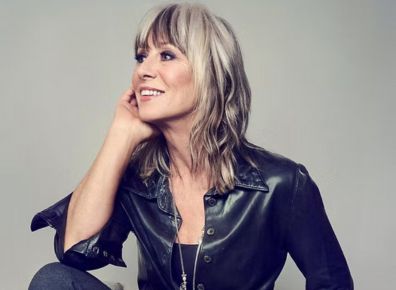
Karen Millen OBE is a British fashion icon who co-founded her eponymous brand in 1981 with Kevin Stanford, starting with a £100 loan and a focus on white shirts.
The first store opened in Maidstone, in 1983, followed by significant expansion throughout the 1990s. Under Karen’s creative direction, the brand became a global fashion powerhouse, with over 130 stores worldwide.
Karen sold the business to Mosaic Fashions in 2004 and shifted her focus to charity work, notably with organisations like HOPEHIV and Teens Unite. She became a prominent voice for female entrepreneurs, advocating for legal and commercial literacy among founders and creatives.
Karen continues to be involved in fashion, interiors and mentorship, sharing the lessons learned from her journey. She was awarded an OBE in 2007 for her services to British fashion.
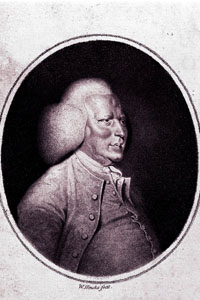
William Shipley was born in Maidstone and became an English drawing master, social reformer and inventor.
At the age of 21, he inherited £500 which he used to practice as a painter and drawing master in Northampton. He also joined the Northampton Philosophical Society, where he began his philanthropic life by raising funds to buy fuel for the poor.
Around 1750, Shipley moved to London and set up a drawing-school near Fountain Court in The Strand. In 1754, he founded an arts society that became The Royal Society of Arts, or Royal Society for the Encouragement of Arts, Manufactures and Commerce (RSA).
The Society offered premiums for useful discoveries and inventions, some of which proved essential to Britain’s flourishing textile industry. It encouraged planting of native trees to support shipbuilding, and exploration was promoted through special prizes, which led to the creation of new and more accurate maps. Today the RSA is still a force for good with a mission to enrich society through ideas and action.
Shipley died in Maidstone in 1803, aged 89, and is buried in All Saints Churchyard. As well as his monument here, there is also an historic plaque on his former home – Knightrider House on Knightrider Street.
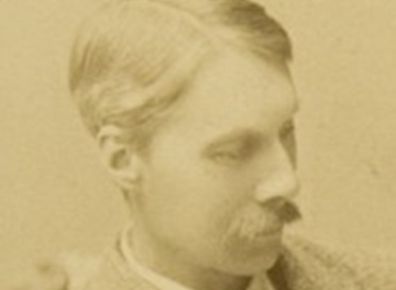
Albert Goodwin was born in Maidstone in 1845. His exceptional artistic ability was recognised at an early age and he went on to study with the Pre-Raphaelite artists Arthur Hughes and Ford Madox-Brown, who predicted Goodwin would become ‘one of the greatest landscape painters of the age.’
Albert’s first painting was exhibited at the Royal Academy when he was just 15 years old. By 1876, he was an associate member of the Royal Watercolour Society (RWS).
The famed art critic John Ruskin took him on a tour of Europe, where he made many sketches from nature which he later turned into watercolours. Albert travelled extensively across Britain and Europe throughout his life. He also visited Canada in 1890, accompanied by his nephew and fellow artist Sidney Goodwin.
Albert was a prolific artist, producing over 800 works and continued to paint well into his eighties. His wide variety of landscape subjects reflect his love of travel and show the influence of Turner, with whom he felt a strong affinity. In later works, he developed experimental techniques such as using ink over watercolour to achieve more atmospheric lighting effects.
His works are also an important record of social history and many fine examples can be seen in Maidstone Museum today.
© Visit Maidstone 2025. All Rights Reserved



